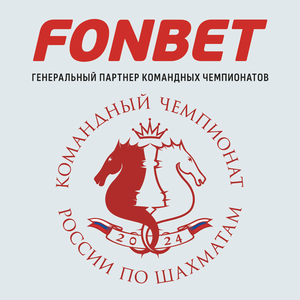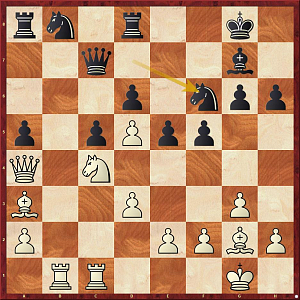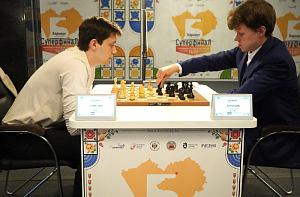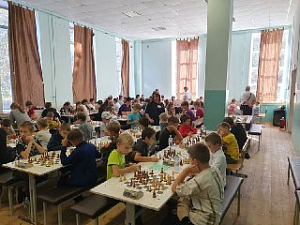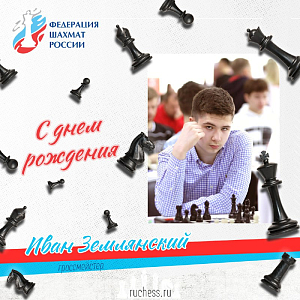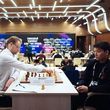26 May 2015
The Advent of a Leader
Round Four review of the FIDE Grand Prix in Khanty-Mansiysk by GM Sergei Shipov.
So, the tournament has finally received its sole leader. I think that no one is surprised that this one is the tournament’s rating favorite. Who else should lead the caravan if not him?
He is the one who has become stable World Number 2. He is the one who has become used to beating Kramnik and, from time to time, would upset no less a person than Carlsen himself. He is the one who made a clean sweep of the field in autumn of last year by starting the super-tournament in St. Louis with a devastating streak of wins with 7 out of 7. He is the one who bears so much resemblance to the young Botvinnik both externally and internally.
He is the one who is strong, consistent and does not fail to punish his rivals for any lack of concentration.
Vachier-Lagrave-Caruana
Maxime is a tough opponent for Fabiano. It can be judged from their lifetime score as before this game it was "+2" in favor of the Frenchman in all formats of chess. The first half of the game developed such that the point gap in the score was likely to be further widened...
1.d4 Nf6 2.c4 e6 3.Nf3 d5 4.Nc3 Bb4 5.cxd5 exd5 6.Bg5 Nbd7 7.Rc1 c6 8.e3 Qa5 9.Bd3 Ne4 10.0–0 Nxg5 11.Nxg5 Nf6 12.Qc2 h6 13.Nf3 Bd6 14.Ne5 Ng4 15.Nf3 Nf6 16.h3 0–0 17.Ne5 a6 18.f4 c5
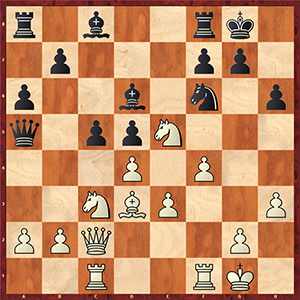
19.g4!
The stable center provides White with fertile ground for active play on the kingside.
19...cxd4
The immediate 19...Be6 is yet another relevant possibility.
20.exd4 Be6
Now the idea of White launching a direct attack suggested itself, where one of the key roles should be played by his queen. The question is how to best deploy the heavy pieces? In my analysis I kept finding the counterplay resources for Black in the center in all lines.
Here is one of the most picturesque continuations: 21.Qf2 (also possible is 21.Qg2! Qb6 22.Qf2, which is met strongly by 22... Rad8! 23.Rce1 Bb8!) 21... Rac8 22.a3 Bxa3!? 23.g5 hxg5 24.fxg5 Ne4 25.Qh4 Rxc3 26.g6 fxg6 27.Nxg6 Rf6 28.Qh8+ Kf7 29.Ne5+ Ke7 30.Qxg7 + Kd6.
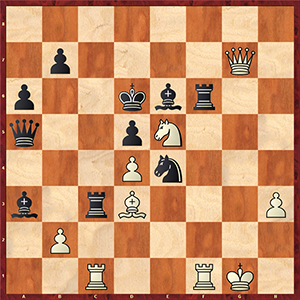
This is the kind of adventures that White should have striven for. After 31.Rxc3 Rxf1+ 32.Kxf1 Nxc3 33.bxa3 Bxh3+ 34.Kg1 Nb5 35.Qg3 Qa4!! 36.Nf3+ Kc6 37.Qxh3 Nxd4 the draw can be agreed any time now as it is not “beyond the mountains”. However, this is an after-game analysis only. Over the board the real human players may never get as far as these very mountains.
Anyway, White should have oriented his forces from the center in no other direction but towards the kingside. Maxime, however, has suddenly decided to turn left.
21.Qb3?!
Was it the idea of taking the small ugly b7-pawn that he was lured into? He might have forgotten, among other things, that ugly ducklings sometimes turn into beautiful swans.
21...b5!
Now the black queen heads for b6 to exert pressure on d4.
22.f5
We are not going to step back with the queen, are we?
22...Qb6! 23.Nf3 Bc8!
The bishop is transferred to b7. What was White’s reason behind weakening his center and back ranks like this after all?
24.Kg2
By all appearances, Vachier-Lagrave pinned his hopes on his opponent’s time trouble. This explains his fast and shallow moves. The following “silicon” continuation could have been uncovered only upon very deep evaluation of all possibilities 24.Nxd5 Nxd5 25.Be4! (much weaker is 25.Qxd5 Bb7 26.Qb3 Rae8 with attack for Black) 25...Nc7 26.Rc6 Qb8 27.Rxd6 Ne8 28.Bxa8 Qxd6 29.Kg2 Nf6.
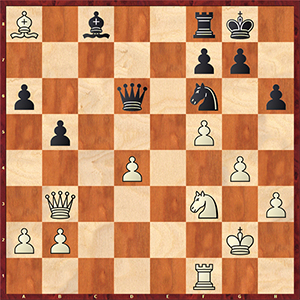
This position still features drawing chances for White. In some lines an extra pawn could be returned back in exchange for further trade of pieces. 30.Ne5 Qxd4 31.Re1 Qd2+ 32.Kf1 does not look entirely convincing in view of 32...a5, followed by the black bishop landing on a6.
Stronger is 30.Qd3 Bd7 31.Be4 Nxe4 32.Qxe4 Bc6 (32...Re8 33.Qc2 Bc6 34.Qc5!) 33.Qe5 Qd8! 34.Qc5 Bb7 35.Kf2 (35.Re1) 35...Re8 36.d5 with hopes for better.
24...Bb7 25.Na4 Qa7 26.Nc5 Rac8
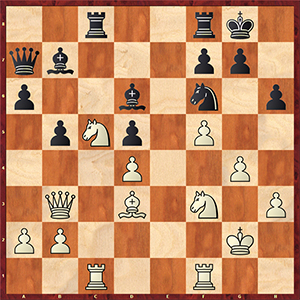
Should White not have failed to recognize this as the critical moment to stop his hasty play and get down to deep thinking, I am more than sure that Maxime would have found the right idea of depriving Black of his assault weapon via 27.Nxb7 Qxb7 28.a4 b4 29.a5, when his position would have still remained viable.
27.a4? Bxc5 28.dxc5
28.Rxc5 Rxc5 29.dxc5 d4! 30.axb5 is only very slightly better for White in comparison to what happened in the game as Black can even abstain from recapturing on b5 – 30...Qb8! 31.Qc4 Nd5 32.Kf2 axb5 33.Qxb5 Nf4 with a devastating attack.
28...d4!
This provides the black bishop with an unobstructed view of the white king.
29.axb5 axb5 (29...Qb8!?) 30.Qxb5 Bc6!
Fabiano demonstrates a great deal of good judgment as hasty 30...Nd5 allows White to complicate the game with 31. c6!
31.Qb6 Qd7 32.Kg1 Rfe8
Black is gradually deploying his pieces to active squares. With his queen being so remote from the main theater of actions, White is unable to coordinate his defensive measures properly.
33.Rce1 Rxe1 34.Nxe1 Re8 35.Ng2
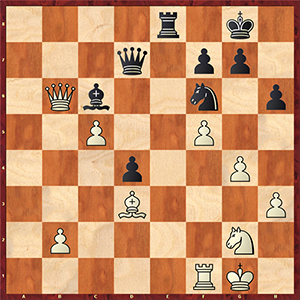
35...Nd5 36.Qb3 Ne3
This is a decisive penetration.
37.Nxe3 dxe3 38.Qc4 Qc7 39.Qf4 Qxf4 40.Rxf4 e2 41.Bxe2 Rxe2 42.Rb4 Rg2+ 43.Kf1 Rc2 White resigns.
Before we switch over to other instructive games, a couple of words needs to be said about the friendly game Jobava-Grischuk. Together with my namesake we experienced difficulties commenting this game online and had to choose our words with great care. Somehow it all happened only too quickly and too obviously without observing the established ceremonies.
I perfectly understand that players are prone to getting tired, losing motivation, and are ready to accept draws to achieve their competitive goals, etc. And yet there still exist some established bounds that are not to be overstepped...
And, by the way, what sense does the tournament-valid rule prohibiting draws before the 30th move make if it is by no means difficult to get by? And when exactly was the last time that the judges interfered into the process so as to object to the artificial repetition of moves in the position full of dynamic possibilities?
The above question has nothing to do with the game between Alexander and Baadur, where a truly inevitable perpetual check was engineered.
But for all that, when has this rule really prevented any of high-caliber chessplayers from winding down their games? The only and the most important practical consequence of this rule is that players often keep imitating intense struggle in the completely drawn positions until the desired move number on the scoresheet is reached. I need hardly say that it all looks rather insincere.
Here we go. I intended to confine myself to saying just "a couple of words" but have brought up a very serious and difficult subject as a result. Well, time will come for me to return to this subject...
In the meantime, let us study other games of the fourth round. No game has so far managed to find its winner. But the game scenarios varied.
Dominguez-Nakamura
1. e4 c5 2.Nf3 Nc6 3.d4 cxd4 4.Nxd4 e5 5.Nb5 d6 6.N1c3 a6 7.Na3 Be7 8.Be3 Nf6 9.Nc4 b5 10.Nb6 Rb8 11.Nxc8 Qxc8 12.Be2 0–0 13.0–0 b4 14.Nd5 Nxe4 15.a3 Bd8 16.axb4
16.Qd3 is another option tested in practice. 16...Nf6 17.Nxb4 Nxb4 18.axb4 Rxb4 19.Qxd6 Rxb2 20.Bxa6 Qxc2 21.Rac1 Qa4? (21...Qb3! 22.Rc8 Qd5=) 22.Rc8 Nd7 23.Rfc1 Rb8 24.R8c6 Qg4 25.Bc8+-, as in Morozevich–Radjabov, Zug 2013.
16...Nxb4
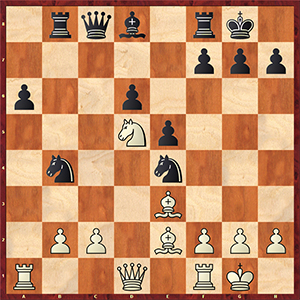
Apparently, this line has yet to be analyzed in more detail. The analysis reveals quite interesting opportunities that have not been tested in practical games yet.
17.Nxb4
This novelty is more natural than the nature itself. Also played here was 17.c3 Nxd5 18.Qxd5 Rxb2 19.Bxa6 Nxc3 20.Qxd6 Qe6 21.Qxe6 fxe6 with complete equality, as in Caruana – Akash, Tromso 2013.
The game Shomoev-Shariyazdanov, Khanty-Mansiysk 2013 saw an unexpected idea 17.Ra4, which should have been answered with 17...Nxd5 (rather than 17...a5) 18.Qxd5 Qxc2! 19.Rxe4 Qxe2 20.Bc5 (20.Ba7 Rb5) 20...Qc2 21.Rc4 Qb3 22.Bxd6 Rc8 23.Rc5 Qxd5 24.Rxd5 Re8 25.Rxe5 – again with complete equality.
Quite an interesting line is 17.Ba7 Rb7 18.Nxb4 Rxb4 19.Bxa6 Qc6 20.Ra2 in which the inclusion of the Be3-a7 move deprives the black rook of the b8-square, so the threat of с2-с3 is created. Even in this position the path to equality exists: 20...Nc5 (20...Bb6!? 21.c3 Bxa7) 21.Be2 Ra4! 22.Bxc5 (22.Rxa4 Nxa4 =+) 22...Rxa2 23.Bxd6 Re8 24.Ba3 Be7 25.Qb1 Qe6 26.Bg4 Qc4 27.Be2 Qe6.
17...Rxb4 18.Bxa6 Qc6! 19.Bd3
Now 19.Ra2 is met strongly by 19...Bg5!, and White cannot retain his bishop pair advantage: 20.Ba7?! (20.c3 Rbb8 21.Qf3=) 20...Nd2! 21.Re1 Ra8 22.Be2 Qb7 23.Qa1 g6 with a slight edge for Black. 19.c4 Rxb2 20.Bb5 is strongly recommended by the computer.
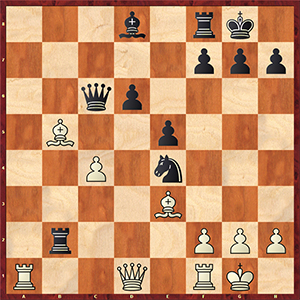
Black can sacrifice the exchange for the second pawn in all lines, either now or later: 20...Qc7 21.Ra3 (also unsuccessful is 21.Qc1 Rb3 22.Qc2? Rxb5 or 21.Bc1 Nc3! and 22...Ne2+) 21...Qb8 22.Qc1 Re2 23.Qd1 Rb2 24.Bc1 Rxb5 25.cxb5 Qxb5 with equality.
19...Rxb2!
By stocking up on a pawn, Black pushes White in the direction of forcing the game.
20.Ra6 Qb7 21.Ra7 Qc6
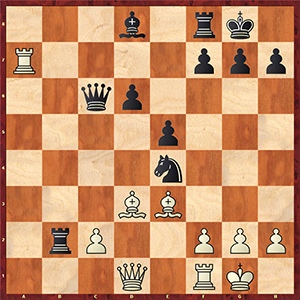
22.Ra6
22.Qa1 Rb8 23.Ra6 Qb7 24.Re1 Rc8 25.c4 Nc5 26.Bxc5 Rxc5 27.Rxd6 Be7 also resulted in equal position.
22...Qb7 23.Ra7 Qc6 Draw.
The next game saw the opening expert running himself into a powerful idea but surviving nonetheless.
Gelfand-Giri
1.d4 Nf6 2.c4 e6 3.Nf3 d5 4.Nc3 Bb4 5.Bg5 h6 6.Bxf6 Qxf6 7.e3 0–0 8.Rc1 dxc4 9.Bxc4 c5 10.0–0 cxd4 11.Ne4 Qe7 12.Nxd4 Bd7 13.Bd3 Nc6 14.Nb3
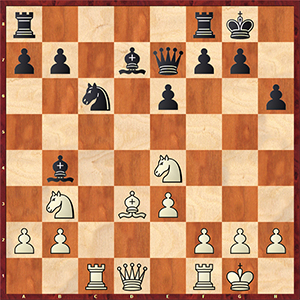
Up to this moment Boris has followed his own path. It was Anish who was the first to step aside.
14...Na5!
This is quite a logical attempt to simplify the game with the trade of pieces. This idea, however, is associated with White’s rook penetrating to с7.
In one of the recent games Black played in a more solid fashion but still failed to equalize completely: 14...Rfd8 15.a3 Ba5 16.Nd6 Be8 17.Nxe8 Qxe8 18.Nxa5 (18.Qe2!? Bb6 19.Be4+=) 18...Nxa5 19.b4 Nc6 20.Qb3 with a slight edge for White, as in Gelfand - Leko, Tsaghkadzor 2015.
15.Rc7 Rfd8
So, what next? It’s White on move and he can use this time to start developing his initiative.
16.a3
All this line is about hunting for the black bishop. However, Black has a counter idea at his disposal. Giri must have analyzed other lines during his home preparation as well. I shall now make a half-hearted attempt to recreate his analysis, at least some of its basic ideas... After 16.Nxa5 Bxa5 17.Rxb7 Black answers with 17...Qf8! (rather than 17...Bb6 18.Bb5!) 18.Qh5!, and it is important now not to fall for the tempting move 18...Bc6? as the being hunted rook can lash back with 19.Nf6+! gxf6
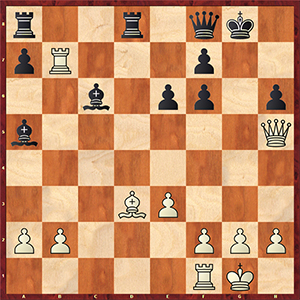
20.Bh7+! Kh8 (20...Kg7 21.Qg6+) 21.Rxf7 and White is winning. Therefore, a calm move 18...Bb6! is stronger as it is being connected with the ideas of f7-f5 and Bd7-c6. White is obliged to continue attacking further with 19.Ng5! f5 (a solid alternative is: 19...Be8 20.Bh7+ Kh8 21.Bb1 Kg8 with equality) 20.Bb5 (20.Bc4 hxg5 21.Rxd7 Rxd7 22.Bxe6+ Rf7 23.Qxg5 Qc5 =+) 20...Bxb5 21.Nxe6 Be8! (21...Qf6?! 22.Rxg7+ Qxg7 23.Nxg7 Kxg7 24.Rc1 Rac8 25.Rxc8 Rxc8 26.g4!±) 22.Qf3 Qf6 23.Rxg7+ Kh8 24.Nxd8 Rxd8 25.Rg3.
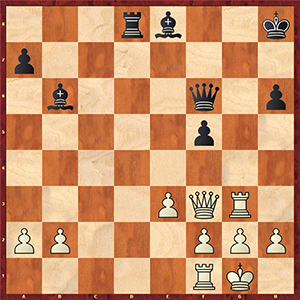
The computer evaluates the situation on the board as approximately equal. As for me, I would not want to struggle against a herd of black bishops with such a ridiculously-positioned rook on g3. The existence of three extra pawns is not a convincing enough argument.
The next important field of research is 16.Nbc5 f5! (the trivial 16...Rac8 is not good in view of 17.Rxd7 Rxd7 18.Nxd7 Qxd7 19.Nf6+ gxf6 20.Bh7+, winning the queen) 17.a3! (it is only Black that can play for a win in the continuation 17.Rxd7 Rxd7 18.Nxd7 Qxd7 19.Nc3 Bxc3 20.bxc3 Rd8) 17... fxe4 18.axb4 (18.Nxe4 Ba4!) 18...exd3 19.Qxd3 (also not good is 19.bxa5 Rac8)
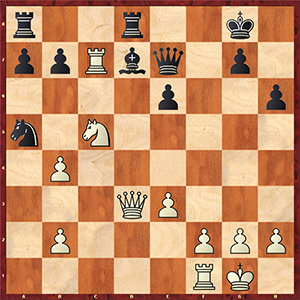
19...Bb5! 20.Rxe7 Bxd3 21.bxa5 (21.Nxd3? Nc6) 21...Bxf1 22.Kxf1.
Technically speaking, White has reasonable compensation for the exchange sacrifice. However, the knight is not so strong when the fight takes place on both flanks of the board. Therefore, I would prefer to play Black’s side in this position– 22...Rd2! etc.
16...Nxb3 17.Qxb3
I am sure that the line 17.axb4 Qxb4 18.Bb1 didn’t go unnoticed with Anish. This is the point of branching for other sublines. In the case of 18...Be8 19.Qc2 White manages to create threats to the black king. However, the analysis proves the position to be approximately equal after: 19...Kf8! (19...f5 20.Ba2) 20.Rc4! (20.Ba2 Nd2!) 20...Qb5 21.Rc3
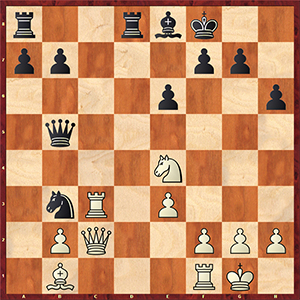
21...Na5! (let us put the embarrassingly simple drawish line with 21...Na1! 22.Qc1 Nb3 23.Qc2 Na1 in the parentheses!) 22.Ng3 g6 23.h4! Qa4 24.b3 Qxh4 25.Qb2! Kg8 26.Rc7.
Now, there exist two continuations that end up in the repetition of moves.
The first continuation: 26...Nc6 27.Ne4 e5 28.f4 Rd7 29.Rxc6 bxc6 30.fxe5 Re7 31.Nf6+ Kf8 32.Bxg6 Qg3 33.Nh7+ Kg8 34.Nf6+ Kf8=.
The second continuation: 26...Rdc8 27.Rxc8 Rxc8 28.Ne4 Bc6 29.Nf6+ Kf8 30.Nh7+ Kg8 (30...Ke8? 31.Rd1!) 31.Nf6+ Kf8=.
Black can try to simplify the game right from the start of the line: 18...Bc6 19.Qg4 Bxe4.
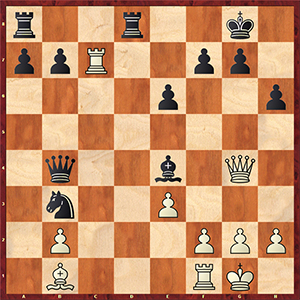
However, some additional nuances spring up in this case: 20.Qf4! (weaker is 20.Bxe4 Qd6 21.Rxb7 Rab8 22.Rxa7?! Nd2 23.Re1 Qb6! 24.Raa1 f5! etc.) 20...Kh8 (20...Qf8 21.Qxe4+=) 21.Bxe4 Nd2 22.Qxf7 Qxb2 23.Rxb7 (23.Bc2 Qf6) 23...Qf6 24.Qxf6 gxf6 25.Rh7+ Kg8 26.Bxa8 Kxh7 27.Rd1 Rxa8 28.Rxd2 a5 with a comfortable rook ending for Black on the one hand but in which White is also not losing on the other hand.
17...Ba5 18.Rxb7
Black has won a pawn, but this is not the end of the world.
18...Ba4!
It is necessary to simplify by trading some pieces.
19.Rxe7
In the case of 19.Qxa4 Qxb7 20.Nc5 the easiest way to equalize is 20...Qc7 21.Be4 Qxc5 22.Bxa8 Rxa8 23.b4 Bxb4, with complete equality.
19...Bxb3
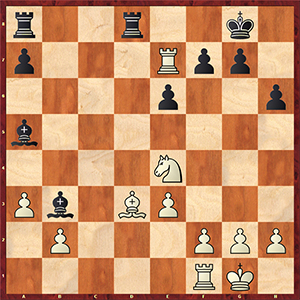
The activity of two black bishops and the unsafe position of the rook on e7 make the situation precarious for White. Gelfand regretted no time for thinking and managed to find a way into a peaceful harbor.
20.Nc5!
20.Ba6 and 20.Bb5 were subjected to analysis by me also and were found not to lose the game.
20...Bb6
Unconvincing is 20...Bd5 21.b4 Bb6 22.Bb5, when the position of the white rook has been secured, while the pawn is still missing.
21.Nxb3
The following sword dance could have only been performed by someone with a pretty turbulent imagination: 21.Nd7 Bc7 22.Nc5 Bd6 23.Rb7 Bd5 24.Rb5 Bc6 25.Ra5 Bc7 26.Ra6 Bb6 27.Be4! Bb5 28.Bxa8 Bxc5 29.Rc6!! (29.Ra5? Bxf1 30.Rxc5 Be2–+) 29...Bf8 30.Bb7 Rd7 31.Ba8 Rd8 32.Bb7=.
By the way, it’s a pity that there are very few such turbulent-minded individuals in this world.
21...Rxd3 22.Nd4!
It was rather unsafe to keep holding on to the pawn: 22.Nc1 Rd2 23.b4 Rb8! (with the threat of Kg8-f8) 24.Nb3 Ra2 25.Nc5 Kf8 26.Rd7 Rxa3 27.Rfd1 Ke8, and White’s position is shaky.
22...Bxd4 23.exd4 Rb8 24.Rxa7 Rxb2
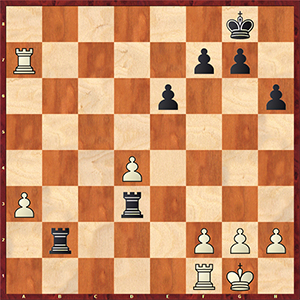
Black aims at winning both White’s weak pawns in order to end up in the ending with “four against three” on the kingside. Boris defended precisely and managed to avoid this unwelcome development.
25.Ra4 Ra2 26.h4!
Worse is 26.g3 g5!
26...g6 27.g3 Kg7 28.Kg2 g5 29.hxg5 hxg5 30.g4 Kf6 31.Re1 Rdd2 32.Rf1 Rd3 33.Re1 Rdxa3 34.Rxa3 Rxa3 35.Rd1 Ke7 36.d5 e5 37.Rb1 Rd3 38.Rb7+ Kf6 39.Rb6+ Ke7 40.Rb7+ Draw.
The encounter between the rivals from the different generations of the Russian National team has also seen the opening preparation meeting its match in the form of common sense exercised over the chessboard.
Svidler-Karjakin
1.Nf3 Nf6 2.g3 c5 3.Bg2 Nc6 4.d4 cxd4 5.Nxd4 e5 6.Nb3 d5 7.Bg5 Be6 8.0–0 Be7 9.Bxf6 Bxf6
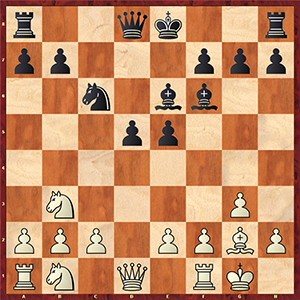
The ideas of Grunfeld and other hypermodernists perfectly identify with Peter. He is capable of discovering new ideas in similar positions full of dynamic possibilities. So, the unexpected surprises were, in fact, quite expected of him.
10.c4!
The unconvincing 10.Nc5 was also tested, for example, 10...e4! 11.Nxe6 fxe6 12.c3 0–0 13.Na3 Be7 14.Nc2 Qb6 15.Rb1 Bc5 16.e3 Ne5 and Black has a slight edge, as in Vakhidov–Mallahi, Shenyang 1999.
10...dxc4
In the case of 10...d4 11.Nc5 Bc8 12.b4! 0–0 13.a3 White would obtain all prerequisites for active play on the queenside.
11.Nc5 e4!?
This is a reasonable extension of the f6-bishop’s scope. Black could have succeeded in saving his bishop from being traded. However, this attempt would fail to equalize completely: 11...Bc8 12.Qa4 0–0 13.Nc3 Qb6 (13...Qd4 14.N5e4) 14.Qxc4 Be7 15.Nd3 Qd4 16.Qxd4 exd4 17.Nb5+=.
12.Nd2!
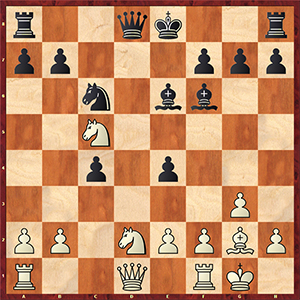
It was played after what seemed like a brief but intense thinking. At one point I almost started to buy into the idea that this resource was discovered over the board. How naive! Please remember, my friends: neither Svidler nor other renowned chess players should be trusted but me! After all, I am no longer an active chess player...
White would gain absolutely nothing by playing 12.Nc3 in view of 12...Bxc3! 13.Qxd8 + (13.bxc3 Qe7) 13...Rxd8 14.bxc3 (14.Nxe6 Rd6!) 14...Bc8 15.Bxe4 (15.Nxe4 Ke7) 15...Na5!, and after that Black would follow up with b7-b6.
12...Bxb2
This is better than 12...e3 13.Nxe6 exf2+ 14.Rxf2 fxe6 15.Nxc4 Qxd1+ 16.Rxd1 Ke7 17.Bxc6 bxc6 18.Kg2 Rhd8 19.Rc1 and White is entitled to all the time in the world to attempt at converting his risk-free advantage in this ending.
13.Nxe6 fxe6 14.Rb1 c3
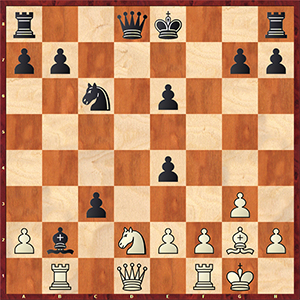
It is difficult to go for this position in advanced calculations. It feels like the chessboard is crowded with only too many black pieces! However, it turned out that this problem can be helped.
15.Bxe4! Qxd2
15...Ne5 suggested itself in order to prevent Black’s knight landing on с4. Now 16.Qb3 Qb6 17.Qa4+ Ke7 or 16.Qc2 Qb6! 17.Bxh7 0–0–0!? afforded no advantage to White.
Most probably Svidler has prepared a subtle continuation 6.Qa4+! Qd7 17.Qc2!, when Black is faced off with some practical problems as the h7-pawn is being attacked and the threat of the Rf1–d1 maneuver is in the air as well. In response to 17...Rd8 it would be quite interesting to test 18.Nf3 Nxf3+ 19.exf3!
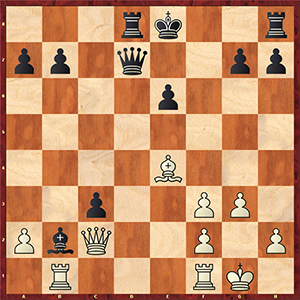
and White keeps an edge in this opposite-colored bishops middlegame.
16. Qxd2 cxd2 17.Rxb2 0–0–0 18.Rd1 Rd4 19.f3
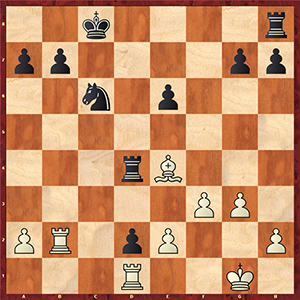
Chess experience tells us that it is White who relishes pleasant prospects in this endgame. The bishop is stronger than the knight and Black has more pawn islands. The sequence of moves 19...h6 20.Rdxd2 (20.e3!?) 20...Rxd2 21.Rxd2 Rd8 suggested itself, when White is left with a slight edge regardless of whether or not the rooks are exchanged.
Sergey, however, managed to come up with an effective practical approach.
19...Rhd8!
Although this may be a losing move, it engineers a lot of obstacles in the way of your opponent. It seems that it was only here that Peter started to be serious about the future developments.
20.Bxh7
Worthy of consideration was 20.Rc2!? in order not to let the black knight out of his stable just yet. Transition into a 4-rook ending is possible, should it be deemed necessary: 20...h6 (20...Kc7 21. Bxh7!; 20...Kb8 21.Bxc6) 21.Bxc6 bxc6 22.Rxc6+ Kb7 23.Rc2 (rather than 23.Rxe6? Rc4–+) 23...Kb6 24.e3 Rd3 25.Kf2
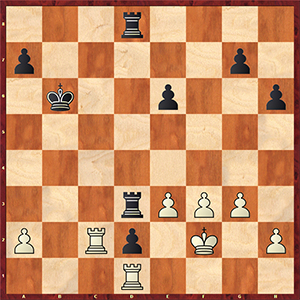
The weakness of the d2-pawn is going to tell soon. One of the possible lines may take the following course: 25...Kb5 26.Ke2 Kb4 27.g4 Ka3 28.f4! R8d7 (28...g6 29.Rcxd2 Rxd2+ 30.Rxd2 Rxd2+ 31.Kxd2 Kxa2 32.e4+-) 29.f5 exf5 30.gxf5 Rd8 (30...R7d5 31.Rc7!) 31.Rcxd2 Rxd2+ 32.Rxd2 Rxd2+ 33.Kxd2 Kxa2 34.e4+-.
20...Ne5 21.h4
This is not an altogether obvious decision. Advancing the rook pawn has a lot of philosophical and theoretical flavor.
There existed for White an opportunity to regroup his forces to get rid of the audacious pawn: 21.Bc2! Nc4 22.Rb3 b5 23.Bd3 a6 24.Kf2 Kc7 25.Bxc4 Rxc4 26.Rb2 with excellent winning chances. For example, 26...g5 (26...Rcd4 27.Ke3±; 26...Kc6 27.h4!) 27.Rbxd2 Rxd2 28.Rxd2 a5 29.e4 b4 30.h4 gxh4 31.gxh4 a4 32.Kg3 b3 33.axb3 axb3 34.Rb2 Rb4 35.h5 Kd6 36.h6 Rb7 37.Kf4 e5+ 38.Kf5 Kc5
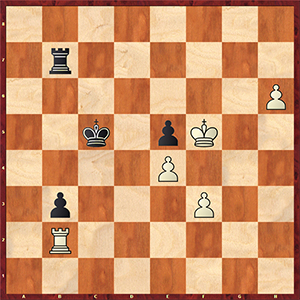
39.Kxe5! (weaker is 39.Rh2 b2 40.h7 Rxh7 41.Rxb2 Kd4 42.Rb4+ Ke3 43.Kxe5 Kxf3 44.Kd6 Rh6+ 45.Kd5 Kf4=) 39...Kc4 40.f4 Kc3 41.Rb1 Kc2 42.Rg1 b2 43.f5 b1Q 44.Rxb1 Kxb1 45.f6 Kc2 46.Kf5 Kd3 47.Kg6 Kxe4 48.h7 Rb8 49.f7 Ke5 50.Kg7+-.
It is as simple a line as a simple line can be!
21...a6!
During the game I had a definite feeling that such a snail-paced preparation of the b7-b5 advance cannot be good for Black. However, it turned out to be no more than just a feeling of premonition!
In the after-game analysis Svidler admitted that he was apprehensive of the 21...g6 continuation. It was all for nothing: 22.Rc2+ Kb8 23.Kf2 Rh8 24.f4! Rxh7 25.fxe5 Rf7+ 26.Kg2 Rf5 (or 26...Rfd7 27.e3 R4d5 28.Kf3 b5 29.Ke2 etc.) 27.e3 Rd8 28.Rdxd2 Rxd2+ 29.Rxd2 Rxe5 30.Kf3 Kc7 31.g4 Rc5 32.Kf4 b5 33.e4 a5 34.e5+-.
22.Rc2+
Without any success is 22.Be4 b5 23.Rc2+ Nc4 24.Kf2 Kc7 25.h5 Kb6 26.g4 Kc5 – and it is Black that enjoys a slight edge.
22...Kb8 23.h5
23.Kf2 is strongly met by 23...g6. 24.f4 would soon end up in a draw after 24...Ng4+ 25.Kf3 Nh2+! 26.Kg2 Ng4 27.Kf3=.
A longer path to a draw was through 24.Rc5 R4d5 25.Rxd5 Rxd5 26.e4 Rd3 27.f4 Ng4+ 28.Ke2 Rxg3 29.Bxg6 Ne3 30.Rxd2 Ng2 31.f5 Nxh4=.
Finally, 24.Rc5 R4d5 25.Rxd2!? Rxd2 26.Rxe5 Rxa2 27.Bxg6 resulted in turbulent complications.
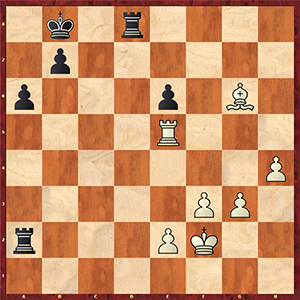
The pawn race is not without risk for White, however - 27...a5 28.h5 a4 29.h6 a3 30.h7 Rad2 31.Bd3 a2 32.Ra5 Kc7 33.g4 Kd6! 34.g5 Ke7 etc.
23...Rh8
Further exchange of material is not dangerous for Black.
24.Be4
During the game 24.Bg6 Nxg6 25.hxg6 seemed promising to me, but the analysis has ruined this spell like sea waves mercilessly ruin sand castles: 25...Rh6 26.Rdxd2 Rxd2 27.Rxd2 Rxg6 28.Kf2 Kc7 29.f4 Rh6 30.Kf3 b5 31.g4 Rh3+ 32.Ke4 Rg3 33.g5 a5 with an approximate equality.
24...Rxh5 25.Rcxd2 Rxd2 26.Rxd2 Kc7
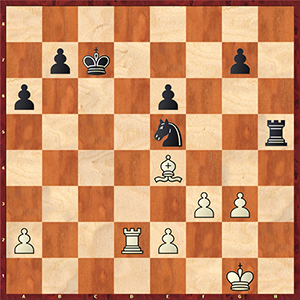
The battle area has narrowed and the knight is capable of successfully standing up to the bishop.
27.Kg2
27.g4 Nc4! 28.Rc2 Rc5=
27...Nc4 28.Rd4 Nd6 29.Bc2 Rc5 30.Bb3 Kd7 31.Rg4 Draw.
Tomashevsky-Jakovenko
In this encounter Dmitry has, in fact, failed to come out of the opening. Having put up a lengthy and stubborn resistance, he has ended up down a pawn, trying to set up some sort of counterplay. But all his efforts would not have been enough had Evgeny been more persistent.
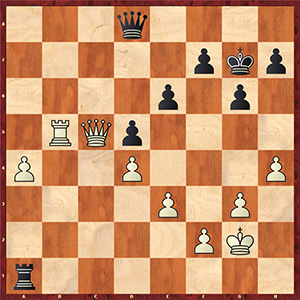
Although the position on the diagram received an extensive thinking from the grandmaster from Saratov, the efficiency of his work on the background of fatigue was apparently low. The 20 minutes of thinking was followed up with a clearly ineffective 41.a5? After 41...Ra2 42.Qc3 h5! it turned out that White lacks any constructive plan to improve his position. Black has established an absolute control over the a5-pawn and is always ready to counterattack on the kingside with Qd8-f6-f5-e4 or g6-g5! There followed 43.Rb6 Ra4 44.Rb5, and the players agreed to a draw.
In fact, in the position on the diagram the eagle eyes of Tomashevsky’s should be directed towards the black king. The a5-pawn would then serve as a distraction and a bait:
41.Qb4!
The white rook would then be dispatched to the 8th rank. I failed to find any safe solutions with queens on the board. For example, 41...Qc8 42.Rb8! Rxa4 43.Qd6 Ra6 44.Qe5+ f6 45.Qf4 Qd7 46.g4! Qf7 47.g5, and 47...e5 48.dxe5 fxg5 49.Qxf7+ Kxf7 50.hxg5+– does not bring any relief. Or 41...h5 42.Rb8! Rxa4 43.Qb7 Qf6 44.Qc8 Kh6 45.Qf8+ Qg7 46.Qe7! Ra6 47.Rb7 (47.Rf8? Ra7!) 47...Ra8 48.Qxf7 Qxf7 49.Rxf7
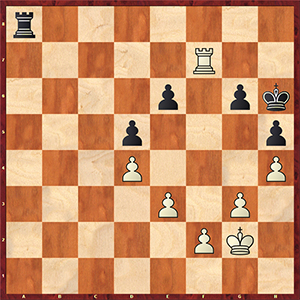
49...Re8 50.f3 e5 (what else?) 51.dxe5 Rxe5 52.Kf2 Re6 53.Rd7 Re5 54.f4 Rf5 55.Kf3+-.
Therefore, Black should have tried to meet the 41.Qb4! idea with the exchange of queens via 41...Qf8 42.Qxf8+ Kxf8 43.a5 h5. However, the resulting rook ending features solid winning chances for White. Let us have a look at this position – 44. Kf3!
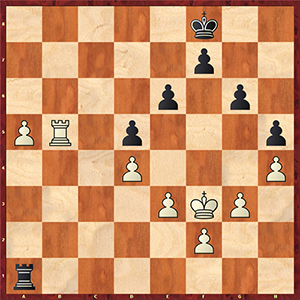
Black’s problem is that White is not obliged to hold on to the f2-pawn. 44...Ra2 is followed by 45.Kf4! Ke7 (45...Rxf2+ 46.Ke5) 46.Kg5 Rxf2 47.a6 Kf8 48.g4! (48.a7?? Kg7) 48...Kg7 49.gxh5 Rg2+ 50.Kf4 Ra2 51.Rb6 gxh5 52.Kg5 Ra3 53.Kxh5 Rxe3 54.Rb7 Ra3 55.a7 Ra4 56.Kg5 Ra2 57.h5 Rg2+ 58.Kf4 Ra2 59.Ke5 Ra6 60.Rc7 Kh6 61.Rxf7 Kxh5 62.Re7 Kg4 63.Rxe6 Rxa7 64.Kxd5+–.
In the case of 44...Kg7 45.Kf4 Kf6 White is going to successfully open up the game via 46.e4 dxe4 47.Kxe4 Ra2 48.f3 Ra4 49.g4!
In my further analysis I failed to find any escape for Black.
This is how our pretty kettle of fish looks like! We kick, but fail to score. It is difficult to measure up to them, Canadians...
To sum up what has been said before, Caruana is in the lead followed by the honorary motorcycle escort in the persons of Dominguez and Svidler.
We are looking forward to other bikers accelerating in a likewise manner!








